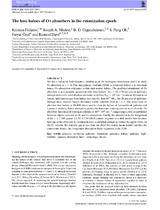The host haloes of O I absorbers in the reionization epoch
Date
2013Author
Finlator, Kristian
Muñoz, Joseph A.
Dave, Romeel
Oppenheimer, B. D.
Peng Oh, S.
Özel, Feryal
Metadata
Show full item recordAbstract
We use a radiation hydrodynamic simulation of the hydrogen reionization epoch to study
OI absorbers at z ∼ 6. The intergalactic medium (IGM) is reionized before it is enriched;
hence, OI absorption originates within dark matter haloes. The predicted abundance of OI
absorbers is in reasonable agreement with observations. At z = 10, ≈70 per cent of sightlines
through atomically cooled haloes encounter a visible (NOI > 1014cm−2) column. Reionization
ionizes and removes gas from haloes less massive than 108.4M , but 20 per cent of sightlines
through more massive haloes encounter visible columns even at z = 5. The mass scale of
absorber host haloes is 10–100 times smaller than the haloes of Lyman-break galaxies and
Lyman α emitters, hence absorption probes the dominant ionizing sources more directly. OI
absorbers have neutral hydrogen columns of 1019–1021 cm−2, suggesting a close resemblance
between objects selected in OI and HI absorption. Finally, the absorption in the foreground
of the z = 7.085 quasar ULAS J1120+0641 cannot originate in a dark matter halo because
halo gas at the observed HI column density is enriched enough to violate the upper limits on
the OI column. By contrast, gas at less than one-third the cosmic mean density satisfies the
constraints. Hence, the foreground absorption likely originates in the IGM.

